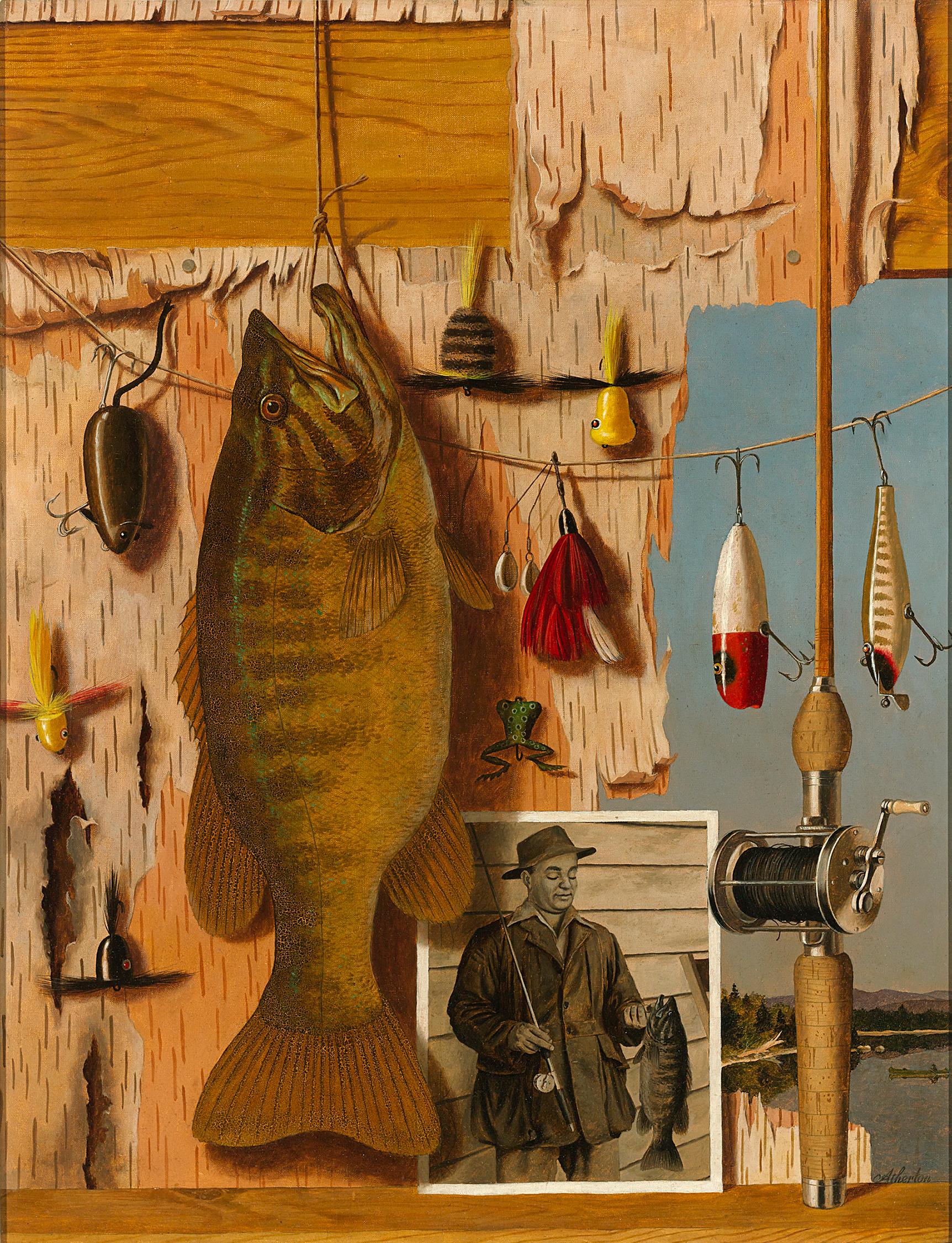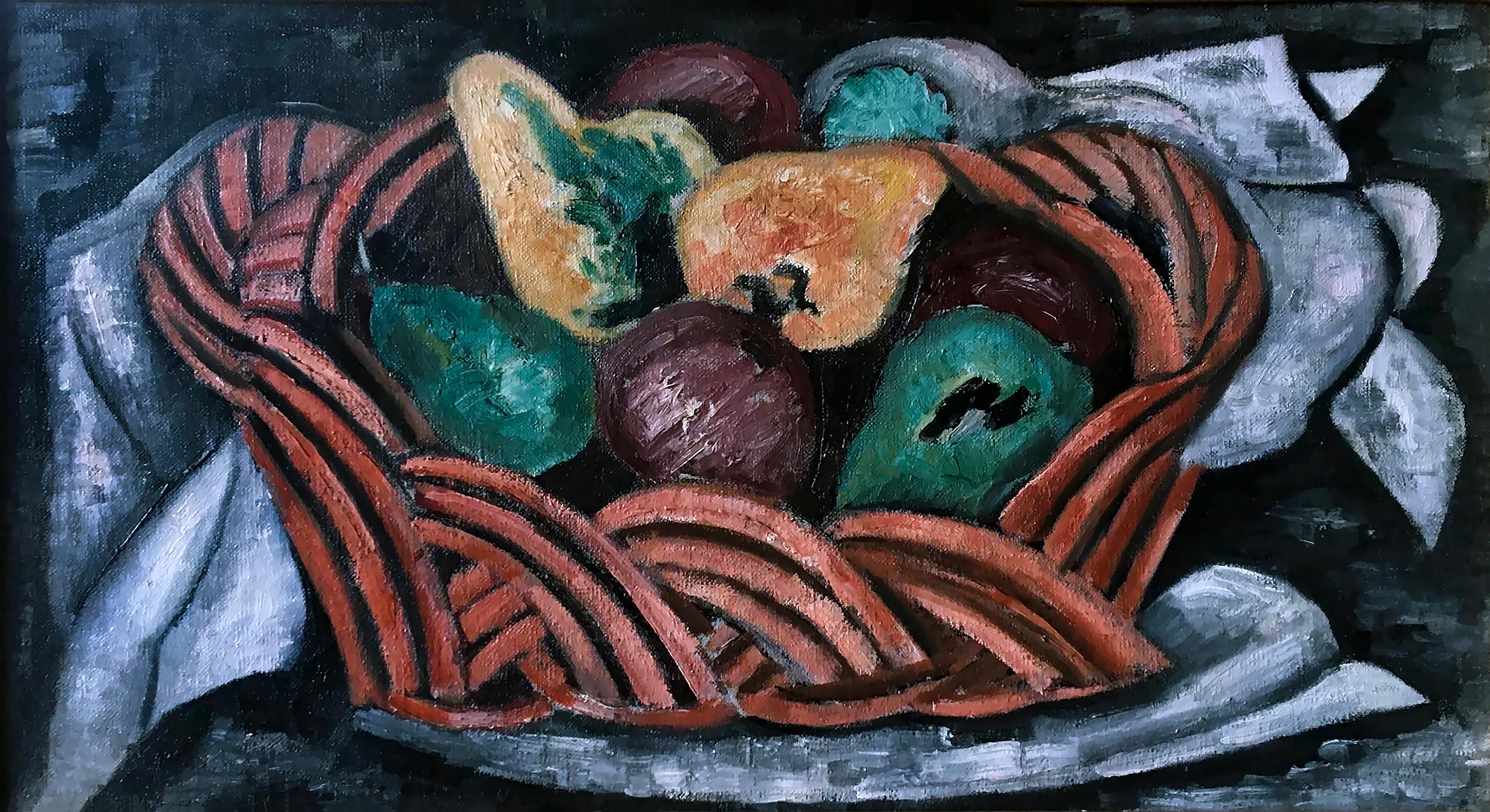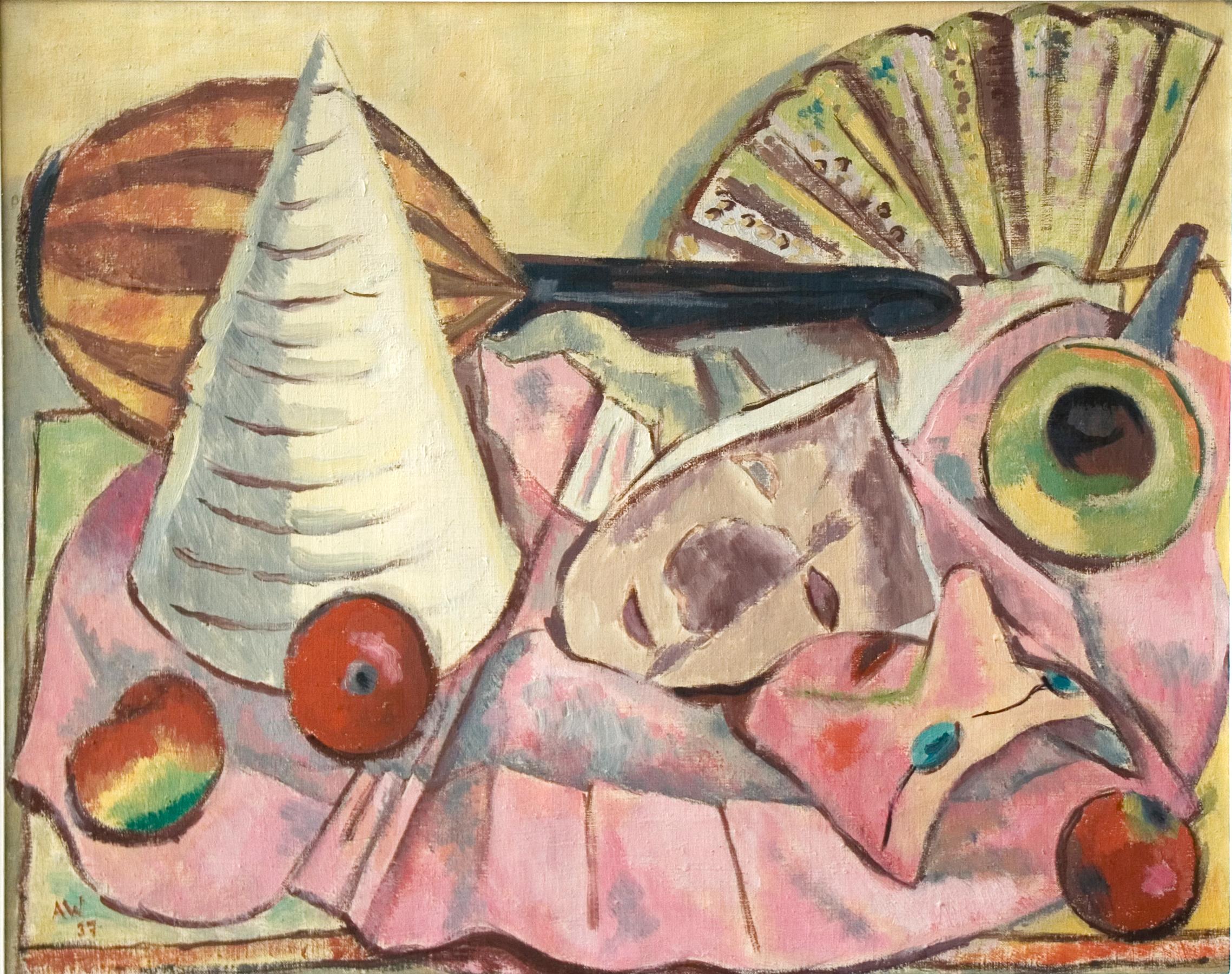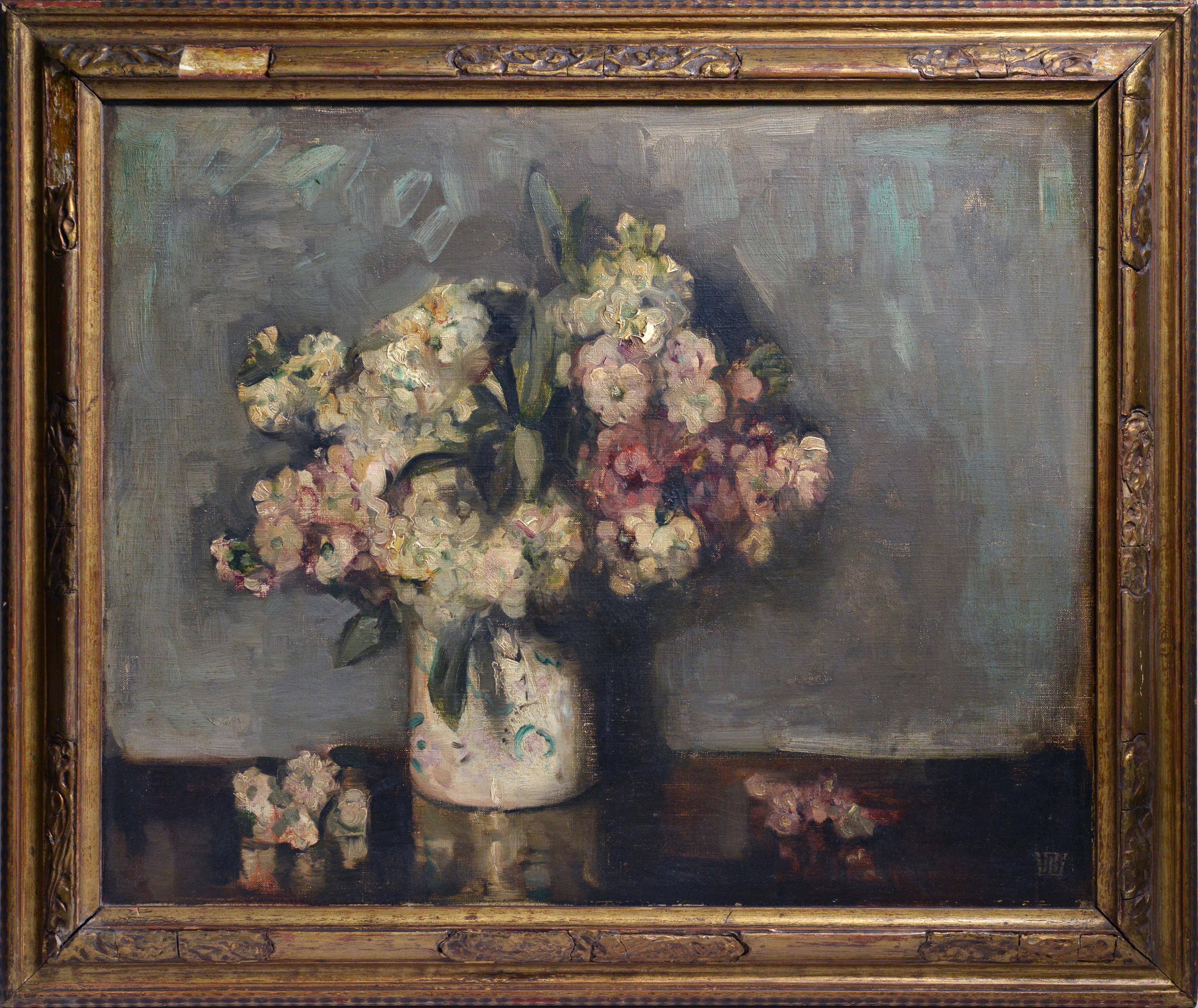Items Similar to "Still Life of Fruit, " Albert Swinden, American Abstract Association, AAA
Want more images or videos?
Request additional images or videos from the seller
1 of 10
Albert Swinden"Still Life of Fruit, " Albert Swinden, American Abstract Association, AAA1937
1937
About the Item
Albert Swinden (1901 - 1961)
Still Life of Fruit, 1937
Oil on canvas
18 x 30 inches
Provenance:
Graham Gallery, New York
Albert Swinden (1901–1961) was an English-born American abstract painter. He was one of the founders of the American Abstract Artists, and he created significant murals as part of the Federal Art Project.
Albert Swinden was born in Birmingham, England in 1901. When he was seven, he moved with his family to Canada, and in 1919 he immigrated to the United States. He lived in Chicago, where he studied for about a year and a half at the Art Institute. He then relocated to New York City, where his art education continued briefly at the National Academy of Design. He soon changed schools again, to the Art Students League, which he attended from 1930 to 1934. He studied with Hans Hofmann and gained an appreciation for Synthetic Cubism and Neoplasticism. According to painter and printmaker George McNeil, Swinden "could have influenced Hofmann ... He was working with very, very simple planes, not in this sort of Cubistic manner. Swinden was working synthetically at this time." While still a student, Swinden began teaching at the Art Students League, in 1932.
Swinden married Rebecca Palter (1912–1998), from New York. Their daughter, Alice Swinden Carter, also became an artist. Carter, who attended the School of the Museum of Fine Arts, Boston, received an award from the Institute of Contemporary Art, Boston for her large sculptures.
Swinden was hired for the Federal Art Project (FAP) of the Works Progress Administration (WPA), and he is best known for the murals which he painted as part of that project.
In 1935, New York City Mayor Fiorello La Guardia attended the opening of the inaugural exhibit at the Federal Art Project Gallery, accompanied by Audrey McMahon, New York regional director for the Works Progress Administration/Federal Art Project. Among the works on display was Abstraction, a sketch by Swinden; it was the design for a mural planned for the College of the City of New York. A newspaper account described it as consisting of "brightly colored T-squares, triangles and rulers in horizontal, vertical and diagonal positions". La Guardia asked what it was, and upon being told it was a mural design, he said he didn't know what it depicted. Someone joked that it could be a map of Manhattan. The displeased mayor stated that "if that's art, I belong to Tammany Hall." (Tammany Hall, which the Republican mayor referenced, was the New York Democratic Party political society.) Fearing that the mayor's negative attitude could jeopardize the future of abstract art within the Federal Art Project, McMahon dispatched an assistant to summon an artist who could speak to the mayor in defense of abstraction. The assistant returned with Arshile Gorky.
Swinden played an important role in the founding of the American Abstract Artists. In 1935, he met with three friends, Rosalind Bengelsdorf, her future husband Byron Browne, and Ibram Lassaw, with the goal of exhibiting together. The group grew and started meeting in Swinden's studio, which adjoined those of Balcomb and Gertrude Greene. The A.A.A. evolved in 1937 out of these meetings among twenty-two artists.
One of the artists attending those meetings was painter John Opper, who said in an interview that Swinden was very quiet, shy, and inhibited. He also said that Swinden was one of the best painters in the group. "His paintings were very powerful, very strong. You would think he would be one of those robust persons like Gorky, for instance. But he was the opposite of Gorky. He was very withdrawn." Around this time, Swinden may have painted abstracts exclusively. But later, according to Irving Sandler, "it was sort of a mixture between figurative and geometric abstraction. It was a kind of hard-edge figure towards the end."
Burgoyne Diller selected Swinden to create a mural for Brooklyn's Williamsburg Housing Project. The other artists chosen for this project were Paul Kelpe, who painted two murals, and Ilya Bolotowsky and Balcomb Greene, each of whom created one. The murals were commissioned in 1936 by the Mural Division of the WPA/FAP in New York. Diller headed the Mural Division.
Swinden's large – 9.31 by 14.36 feet (2.84 m × 4.38 m) – untitled abstract mural has been described as a "carefully balanced, disciplined composition of rectangular shapes punctuated by occasional biomorphic forms". He was not able to execute the mural exactly as he had originally conceptualized, due to constraints of the installation space; for example, the unpainted upper corners which were inserted during restoration are where structural beams were present at the Williamsburg site. The black strip at the top and the broken blue one on the right were probably also changes made due to requirements of using the particular space.
The murals, owned by the New York City Housing Authority, are on loan to the Brooklyn Museum. These five paintings were the first abstract murals anywhere in the United States, and they're considered to be some of the most significant. Art historians have praised the murals as "extremely important artworks, quite courageous and extraordinary ... painted in the most radical style you could get at the time", "key to American art between the wars", and "national treasures".
Among the other murals he created was one for the 1939 New York World's Fair.
Although he did not often write about his art, a short essay of his was published in the American Abstract Artists Yearbook of 1938. This yearbook featured, among other things, essays such as Swinden's which expounded on theories and practices of abstract art. In his essay, "On Simplification", Swinden wrote: "We are moved not only by particular, or individual forms, but by the relationships between the particular forms and their significance as a unity."
A 1940 fire at Swinden's studio destroyed the majority of his early work. His mural for the Williamsburg Project, which had been painted over and considered lost before being rediscovered and restored, is a rare and very significant painting from the period before the fire.
In a 1942 review of the American Abstract Artists' sixth annual exhibition, influential art critic Clement Greenberg wrote that among the "geometricians", Swinden "shows as much promise perhaps in his single unsuccessful painting as the others in their successful ones."
Although he was respected by the prominent artists he associated with, had his paintings exhibited in many group shows (including such prestigious venues as the Museum of Modern Art, the Solomon R. Guggenheim Museum and the Whitney Museum of American Art), and created significant murals, he was not able to promote his art in a commercially successful way. Instead, he often had to work in other capacities, supporting himself as an engineering draftsman or a textile designer.
He died in 1961 in New York City. In 1962, a retrospective exhibit of his work was mounted at New York's Graham Gallery. Swinden left behind a relatively small oeuvre of "calmly classical visions".
- Creator:Albert Swinden (1901 - 1961, American)
- Creation Year:1937
- Dimensions:Height: 19 in (48.26 cm)Width: 31 in (78.74 cm)
- Medium:
- Movement & Style:
- Period:
- Condition:
- Gallery Location:New York, NY
- Reference Number:1stDibs: LU1841210737112
About the Seller
5.0
Platinum Seller
These expertly vetted sellers are 1stDibs' most experienced sellers and are rated highest by our customers.
Established in 2021
1stDibs seller since 2022
61 sales on 1stDibs
Typical response time: 1 hour
- ShippingRetrieving quote...Ships From: Larchmont, NY
- Return PolicyA return for this item may be initiated within 3 days of delivery.
More From This SellerView All
- "Fruit" Georgina Klitgaard, Apples and Pears Still Life, Woodstock Female ArtistBy Georgina KlitgaardLocated in New York, NYGeorgina Klitgaard Apples and Pears Still Life Signed lower right Oil on canvas 8 x 10 inches Georgina Klitgaard’s art has sometimes gotten lost in the critical propensity to assign artists to membership in one school or another. Unfortunately for her posthumous reputation, Klitgaard defied easy characterization. She was a U.S. modernist, working in both oil and watercolors, but never abandoned figurative painting. She made her reputation in landscape but also excelled in portraits, flower studies, and even cityscapes. Yet despite Klitgaard’s ambiguous status in art history, her paintings continue to fascinate viewers attracted to the unsteady ground between twentieth-century realism and expressionism. Georgina Klitgaard (née Berrian) was born in Spuyten Duyvil, New York (now part of the Bronx); the Berrians had lived in the area since at least the U.S. Revolution. After graduating from Barnard College, she studied art at the National Academy of Design. In 1919 she married Kay Klitgaard, a Danish artist and writer. The next year, her life took a decisive turn when the couple visited friends in Woodstock, NY—about 120 miles north of New York City--and fell in love with the area. In 1906, L. Birge Harrison helped found the Art Students League Summer School in Woodstock and the area became a magnet for landscape painters. The Klitgaards bought a house in 1922 on a steep ledge at the end of Cricket Ridge, high above Bearsville, which provided panoramic vistas overlooking the Catskill Mountains and the Hudson Valley. Klitgaard joined the artists’ colony in the area, which at the time included artists Ernest Fiene and Katherine Schmidt. Klitgaard exhibited widely and her career slowly developed momentum. She was a regular contributor at Whitney Museum shows from 1927 to 1944. In 1929, she exhibited a painting entitled “Carousel” in the Whitney Studio Club’s famous exhibition “Circus in Paint.” Gertrude Vanderbilt Whitney acquired five paintings by Klitgaard in the early 1930s and served as a significant patron for the artist. Klitgaard s New York dealer, Frank Rehn...Category
Early 20th Century Modern Still-life Paintings
MaterialsCanvas, Oil
- "Floral Still Life Arrangement" Frederick Jessup, Butterflies, Wine BottleBy Robert JessupLocated in New York, NYFrederick Arthur Jessup Still Life Arrangement Signed lower left Oil on canvas 18 1/2 x 22 inches Provenance: Findlay Galleries, New York Private Collection, New YorkCategory
Mid-20th Century Modern Still-life Paintings
MaterialsCanvas, Oil
- "Ethnographic Still Life, " Edith Kramer, African Mask and Shofar, Art TherapyBy Edith KramerLocated in New York, NYEdith Kramer (1916 - 2014) Still Life with Mask, n.d. Oil on canvas 26 x 20 inches Signed and titled on the stretcher Provenance: Estate of the artist Kramer was born in Vienna, Austria-Hungary in 1916. At age 13 Kramer began art lessons with Friedl Dicker. Dicker was graduate of the Bauhaus in Weimar, Germany and was an artist and art teacher of note. Kramer studied drawing, sculpture and painting, and was influenced by the method for teaching art developed by Bauhaus artist Johannes Itten. It was in 1934 after Kramer graduated from Realgymnasium that she, then 18, followed Dicker to Prague to continue to study under her. During this time in Prague, Kramer witnessed the therapeutic impact of art when she assisted Dicker in teaching art to the children of political refugees. With the threat of Nazi invasion looming, Kramer took refuge in America in 1938. In New York City, she worked for three years teaching sculpture at a progressive school called the Little Red School House. During World War II Kramer worked as a machinist at a tool and die shop in the Soho district of New York City. She stayed after her shift to draw the other workers in their industrial setting. These works were rendered in the social realist style. In 1947 Kramer visited some of the earliest known artwork, in the caves at Lascaux. Kramer spoke of these cave paintings as an example of the universal language of art. At the age of 33 she returned to New York City, with hopes of making a living as an artist. Still in her 33rd year, Kramer was offered a job at Wiltwyck School for Boys, a school and residential treatment facility for children with behavioral and emotional needs. This job was arranged for her by psychoanalyst and board member at Wiltwyck, Dr. Viola Bernard. Dr. Bernard gave Kramer the title, "Art Therapist," noting that few teachers were willing to work with such challenging students. It was here that Kramer worked with disturbed boys, ages 8 through 13, for the following seven years. Raised in a family which was interested in psychoanalytic theory, Kramer herself became a follower of Sigmund Freud. Kramer especially believed in the concept of sublimation. Freudian theory describes sublimation as a process in which primitive urges coming from the id are transformed into socially productive activities that lead to gratification of the original urge. Kramer's training was in art, art education and psychoanalytically informed psychotherapy. Kramer believed sublimation to be one of the most vital goals of art therapy...Category
20th Century American Modern Still-life Paintings
MaterialsCanvas, Oil
- "Sunflowers, " Frank London, Modernist Yellow Floral Still Life with WindowLocated in New York, NYFrank Marsdon London (1876 - 1945) Sunflowers Oil on canvas 31 x 22 inches Signed lower right Exhibited: Pittsburgh, Carnegie Museum of Art. Frank Marsden London was born in the small Southern town of Pittsboro in central North Carolina in 1876. When he reached adulthood, London attended the University of North Carolina...Category
1920s American Modern Still-life Paintings
MaterialsOil, Canvas
- "Lemons and Pear" Marsden Hartley, Colorful Fruit Still Life, Modern ArtBy Marsden HartleyLocated in New York, NYMarsden Hartley Lemons and Pear, circa 1922-23 Oil on canvas 9 x 10 3/4 inches Provenance: Adelaide Shaffer Kuntz, Bronxville (Hartley’s friend and patron) Bertha Schaefer Gallery, New York (acquired from the above) Private Collection, Stamford, Connecticut (acquired from the above) Barridoff Galleries, Portland, Maine, April 7, 1984, Lot 29 (as Still Life with Pear and Lemons) Richard Ward Foster (acquired at above sale) Sotheby's New York, American Art, October 6, 2017, Lot 32 Private Collection (acquired from the above) Exhibited: (possibly) Kantstrasse, Berlin, Private showing in artist’s studio, 1923. (possibly) New York, Bertha Schaefer Gallery, Still Life Painting by European and American Painters, 1944. Born in Lewiston, Maine, Marsden Hartley became one of the most famous early modernist artists of twentieth-century American art, known for landscapes, still lifes, and some portraits. His painting showed a focus on monumental shapes, especially clouds and landscape forms, and his unique style has been described by critic Sadakichi Hartmann as "an extreme and up-to-date impressionism" and "emerging modernism that evolved through Impressionism". (Gerdts 291) He had a lonely, insecure childhood because his mother died when he was eight years old, and he was raised by an older sister when his father left to remarry. He studied art in Cleveland, Ohio and then in 1898 went to the Chase School in New York and at the National Academy of Design. He continued to spend much time in Maine painting landscapes, and by 1909 had his first exhibition, which was held at New York Gallery 291, run by Alfred Stieglitz. There he became involved with a social circle of modernists that included Georgia O'Keeffe, Arthur Dove, and John Marin. In 1912, he first went to Europe where he had further exposure to modernism, and from 1913 to 1915 he was in Germany. In Paris, he experimented with Cezanne-like still lifes and was befriended by Gertrude Stein. In Germany, he was influenced by Expressionism, and especially by military pageantry. It is said that his greatest contribution to early 20th-century American modernism has been his brilliant synthetic military icons known as German Officer Portraits. He developed a close homosexual relationship with a handsome young Prussian officer who was killed in World War I. Being encouraged by Stieglitz to explore American subjects, Hartley turned to American Indian objects...Category
1920s Still-life Paintings
MaterialsCanvas, Oil
- "Candelabra, " Edward Millman, Colorful Abstract Expressionist Still LifeLocated in New York, NYEdward Millman (1907 - 1964) Candelabra, 1962 Signed lower right; titled and dated on the reverse Oil on canvas 41 3/4 x 31 1/2 inches Provenance: The ...Category
1960s Abstract Abstract Paintings
MaterialsCanvas, Oil
You May Also Like
- Still Life on a Table - Oil Painting on Canvas - 20th CenturyLocated in Roma, ITStill Life on a Table is an original oil painting on canvas realized in the 20th Century. Good conditions (the painting has been restored in some parts). Frame included (83x108 cm).Category
20th Century Modern Figurative Paintings
MaterialsCanvas, Oil
- The Bass Season by John AthertonLocated in New Orleans, LAJohn Atherton 1900-1952 American The Bass Season Saturday Evening Post cover, June 29, 1946 Signed "Atherton" (lower right) Inscribed "The Bass Season opens in the east July 1st /...Category
20th Century American Modern Still-life Paintings
MaterialsCanvas, Oil
- Basket with FruitBy Marsden HartleyLocated in Miami, FLBold outlines and strong weighty forms coalesce with a compositional delicacy that forms the hallmark of Hartley's work. The work has a long and distinguished provenance and exhibit...Category
1920s American Modern Still-life Paintings
MaterialsOil, Canvas
- Fasching / CarnevalBy Alfred WickenburgLocated in Wien, 9Monogr. and dat. lower left: AW / 37 The work is present in the catalogue raisonné of the Belvedere under the number Ex 26402. Provenance: Private property, Graz (Austria) Catalogu...Category
1970s Modern Still-life Paintings
MaterialsCanvas, Oil
- Russian Modern Still life Bouquet of flowers Early 20th century Oil paintingLocated in Stockholm, SESigned, monogram: Pavel Aleksandrovich Shillingovsky (1881 - 1942). Russian artist, master of graphics, representative of modern and neoclassical. He rarely painted with oil paints, ...Category
Early 20th Century Modern Still-life Paintings
MaterialsCanvas, Wood, Oil
- Peter Collins ARCA: 'Still Life with a Fruit Bowl' 20th century oil paintingBy Peter Collins ARCALocated in London, GBTo see our other Modern British Art, and our other Peter Collins works, scroll down to "More from this Seller" and below it click on "See all from this Seller" - or send us a message...Category
1940s Modern Still-life Paintings
MaterialsOil, Canvas
Recently Viewed
View AllMore Ways To Browse
When Life Is Still
Vintage Style Modern Life
Early American Still Life
American Review
Key Of Life
Early American Artwork
Large Modern Still Life
Albert York
American Federal Art
Still Life Of Fruit
Albert Painter
Albert Gray
Party Of Life
Albert Oil Painting
Still Fruit
Still Life Paintings Of Fruit
Fruit Top
1912 American




